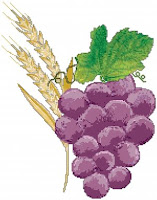Obviously, for Christians Easter is the most significant holiday of the liturgical year, as it celebrates rebirth, regrowth, new spiritual beginnings, and a new life in the most spectacular fashion.
But there are fascinating historical aspects of Easter that lend it other nuances. For one, it's the only "movable" holiday in the Western liturgical calendar--that is, like almost all Hebrew and Muslim holidays, it's calculated by a lunar or "lunisolar" method, while other Christian holidays have set dates in the Gregorian calendar. Easter 2013, for instance, falls on the first Sunday (31st March) after the first full moon (27th March) after 20th March (the Spring Equinox). Hence, in any given year it can occur from March 22nd to April 25th; according to one scholar, the year-to-year sequence of Easter dates is so complex that it "
takes 5.7 million years to repeat"!

This lunisolar calculation is similar to Jewish Passover or Pesach, which occurs around the same time as Easter and marks the beginning of the harvest season in Israel, as well as celebrating the Jews' release from
bondage into a new life (mirroring the theme of rebirth in Christian Easter). The seven foods that were sacred to the Jews (of which Jesus was one) symbolized the seasons of a year's farming, the Jewish connection to the "good land," and a hoped-for abundant harvest--pomegranates, dates, olives, figs, grapes, and wheat (linked with Passover). Jesus' selection of wheat and grapes (wine) at the last Passover meal to represent an abundant "new life," hence, is symbolically profound both theologically and in terms of the land, the soil.
Further, vis-a-vis farming, the March full moon is called the
Worm Moon, a name bestowed on it by the Algonquins, as this is when the ground begins to soften and worms with their castings reappear, worm-castings (poop) being one of the richest components of the soil and a sure sign of healthy, fertile, organic soil. That's also
why robins are so numerous at this time of year, eating lots of worms in early-morning darkness before they lay their eggs around mid-morning (click here for more).
The connection between eggs, the moon, fertility, and the growth of new life is at the heart of much Easter symbolism, if you go back far enough in history.
"Easter," for instance, according to the English monk and Christian writer Bede, was named after
"Eostre" or "Ostara," the Saxon dawn-goddess of fertility and new life. Eostre had many goddess-analogues in other cultures, including Aphrodite, Astarte, Ishtar, Hathor, Kali, and Demeter (
mother of Persephone; we talked about Persephone's symbolism in farming in an earlier post [click here]).
What links these goddesses with both Easter and farming is their association with earth's fertility, fostered through cycles of death/darkness/dirt and life/light/air, both seasonally and liturgically. Kali, for instance, in Hindu culture, was described as "the ground," meaning "the mysterious source of life," "ultimate reality," and "the very soil, all-creating and all-consuming." As farmers and gardeners, we need to revere "the ground"--that is, the soil, the humus, which is the earthly source of life and growth--and we need to understand both its productive and destructive cycles, that life springs from death, which of course is also the idea behind the Easter liturgy.
In their role as progenitors of fertility, these goddesses sometimes were
 |
| The hare's decorated egg-gift |
symbolized by eggs, which of course are a source of new life. Our popular custom of giving Easter eggs thus also has ancient roots. As far back as 3000 BCE in ancient Persia, red-dyed eggs were given to mark the start of spring.
But why are our Easter eggs delivered by a rabbit? According to one legend, the goddess Eostre found an injured bird and saved its life by transforming it to a hare (another animal associated with springtime and fertility). But the transformation was incomplete, and the hare retained the bird's ability to lay eggs. To thank Eostre for its life, the hare decorated its eggs, leaving them as gifts for Eostre. The
constellation Lepus,which can be seen just south of Orion, is, in fact, Eostre's egg-laying hare!
Think of that when you watch our new hens this spring and summer at the Farm! Think of Eostre's dying bird, reborn as a rabbit!

 This lunisolar calculation is similar to Jewish Passover or Pesach, which occurs around the same time as Easter and marks the beginning of the harvest season in Israel, as well as celebrating the Jews' release from
This lunisolar calculation is similar to Jewish Passover or Pesach, which occurs around the same time as Easter and marks the beginning of the harvest season in Israel, as well as celebrating the Jews' release from

















